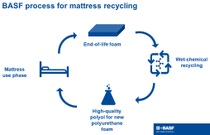Isocyanates and Polyols
Towards a circularity in recycling of mattresses
After an average of ten years most mattresses today are thrown away, thus squandering resources and creating high quantities of waste. At the same time, valuable raw materials are needed to manufacture new soft foam mattresses - above all crude oil. A circular economy solution for mattresses can therefore both reduce waste and save fossil resources.
At BASF, we are continuously looking at ways to reuse and re-enter waste into product lifecycles and to foster circular economy solutions. With the circular economy concept BASF aims to decouple economic growth from the use of finite resources and is accelerating the adoption of these principles into our day-to-day operations. BASF offers a solution to finally closing the loop for polyurethane soft foam with the chemical recycling of mattresses.
Laboratory tests have successfully started at the Schwarzheide site in Brandenburg, Germany for this purpose. By taking this step, BASF is breaking new ground and responding to the raised expectations of the foam and mattress industry as well as those of consumers. At the same time, it underlines its own efforts to increase sustainability.

BASF’s process breaks down the flexible polyurethane and delivers the initially used polyol. From there BASF can produce new foam with a significantly lower carbon footprint, because fewer fossil resources are used.
Benefits of mattress recycling
- Mattresses are easy to collect and to sort out
- Post-consumer material which has so far been landfilled or incinerated is recovered
- The recycled materials can be used for the production of new mattresses
- Production of new foam with a significantly lower carbon footprint because in total less fossil resources are used
- Quality comparable to that of non-recycled raw materials